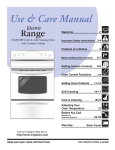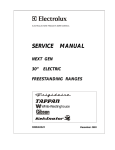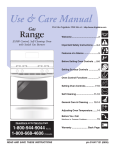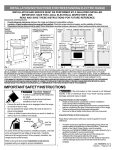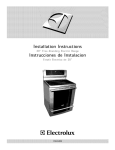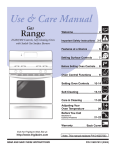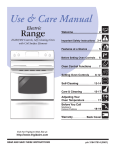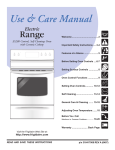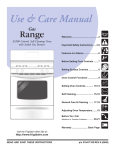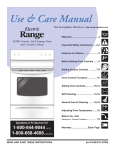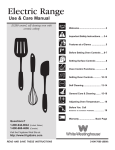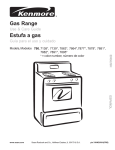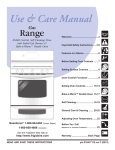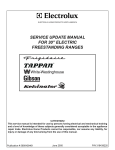Download Electrolux Floor-mounted stoves Operating instructions
Transcript
Note: This manual replaces P/N 316257105 Welcome & Congratulations Questions? 1-800-944-9044 (United States) 1-866-729-5199 (Canada) Please attach sales receipt here for future reference. Congratulations on your purchase of a new range! At Electrolux Home Products, we are very proud of our product and are completely committed to providing you with the best service possible. Your satisfaction is our number one priority. We know you’ll enjoy your new range and Thank You for choosing our product. We hope you consider us for future purchases. PLEASE CAREFULLY READ AND SAVE THESE INSTRUCTIONS This Use & Care Manual provides specific operating instructions for your model. Use your range only as instructed in this manual. These instructions are not meant to cover every possible condition and situation that may occur. Common sense and caution must be practiced when installing, operating and maintaining any appliance. Please record your model and serial numbers below for future reference. Model Number: Serial Number: Purchase Date: Product Registration Register Your Product The self-addressed PRODUCT REGISTRATION CARD should be filled in completely, signed and returned to Electrolux Home Products. © 2003 Electrolux Home Products, Inc. All rights reserved This Use & Care Manual contains general operating instructions for your range and feature information for several models. Your range may not have all the described features. The graphics shown are representational. The graphics on your range may not look exactly like those shown. 2 Important Safety Instructions Read all instructions before using this appliance. Save these instructions for future reference. This manual contains important safety symbols and instructions. Please pay attention to these symbols and follow all instructions given. This symbol will help alert you to situations that may cause serious bodily harm, death or property damage. This symbol will help alert you to situations that may cause bodily injury or property damage. • Remove all tape and packaging before using the range. Destroy the carton and plastic bags after unpacking the range. Never allow children to play with packaging material. • Proper Installation—Be sure your appliance is properly installed and grounded by a qualified technician in accordance with the National Electrical Code ANSI/NFPA No. 70 latest edition and local electrical code requirements. Install only per installation instructions provided in the literature package for this range. Ask your dealer to recommend a qualified technician and an authorized repair service. Know how to disconnect the power to the range at the circuit breaker or fuse box in case of an emergency. • User servicing—Do not repair or replace any part of the appliance unless specifically recommended in the manuals. All other servicing should be done only by a qualified technician. This may reduce the risk of personal injury and damage to the range. • Never modify or alter the construction of a range by removing leveling legs, panels, wire covers, anti-tip brackets/screws, or any other part of the product. Do not store items of interest to children in the cabinets above a range or on the backguard of a range. Children climbing on the range to reach items could be seriously injured. Never Use Your Appliance for Warming or Heating the Room. • Storage in or on Appliance—Flammable materials should not be stored in an oven, warmer drawer, near surface units or in the storage drawer. This includes paper, plastic and cloth items, such as cookbooks, plasticware and towels, as well as flammable liquids. Do not store explosives, such as aerosol cans, on or near the range. • Do Not Leave Children Alone—Children should not be left alone or unattended in the area where appliance is in use. They should never be allowed to sit or stand on any part of the appliance. • DO NOT TOUCH SURFACE UNITS, AREAS NEAR THESE UNITS, HEATING ELEMENTS OR INTERIOR SURFACES OF THE OVEN. Both surface units and oven heating elements may be hot even though they are dark in color. Areas near surface units may become hot enough to cause burns. During and after use, do not touch, or let clothing or other flammable materials touch these areas until they have had sufficient time to cool. Among these areas are the cook top, surfaces facing the cook top, the oven vent openings and surfaces near these openings, oven door and window. • Wear Proper Apparel—Loose-fitting or hanging garments should never be worn while using the appliance. Do not let clothing or other flammable materials contact hot surfaces. • Do Not Use Water or Flour on Grease Fires—Smother the fire with a pan lid, or use baking soda, a dry chemical or foamtype extinguisher. • When heating fat or grease, watch it closely. Fat or grease may catch fire if allowed to become too hot. • Use Only Dry Potholders—Moist or damp potholders on hot surfaces may result in burns from steam. Do not let potholders touch hot heating elements. Do not use a towel or other bulky cloth instead of a potholder. • Do Not Heat Unopened Food Containers—Buildup of pressure may cause container to burst and result in injury. • Remove the oven door from any unused range if it is to be stored or discarded. Stepping, leaning or sitting on the doors or drawers of this range can result in serious injuries and also cause damage to the range. Do not allow children to climb or play around the range. The weight of a child on an open door may cause the range to tip, resulting in serious burns or other injury. IMPORTANT—Do not attempt to operate the range during a power failure. If the power fails, always turn off the range. If the range is not turned off and the power resumes, the range will begin to operate again. Once the power resumes, reset the clock and oven function. Do not use the oven or warmer drawer (if equipped) for storage. 3 Important Safety Instructions IMPORTANT INSTRUCTIONS FOR USING YOUR IMPORTANT INSTRUCTIONS FOR USING YOUR OVEN COOKTOP • Use Care When Opening Oven Door or Warmer Drawer (if equipped)—Stand to the side of the range when opening the door of a hot oven. Let hot air or steam escape before you remove or replace food in the oven. • Keep Oven Vent Ducts Unobstructed. The oven vent is located under the left rear surface element if your model is equipped with coil elements. The oven vent is located below the backguard for models equipped with ceramic-glass cook tops. Touching the surfaces in this area when the oven is operating may cause severe burns. Also, do not place plastic or heat-sensitive items on or near the oven vent. These items could melt or ignite. • Placement of Oven Racks. Always place oven racks in desired location while oven is cool. If rack must be moved while oven is hot use extreme caution. Use potholders and grasp the rack with both hands to reposition. Do not let potholders contact the hot heating elements in the oven. Remove all utensils from the rack before moving. • Do not use the broiler pan without its insert. The broiler pan and its insert allow dripping fat to drain and be kept away from the high heat of the broiler. • Do not cover the broiler insert with aluminum foil. Exposed fat and grease could ignite. • Protective Liners—Do not use aluminum foil to line the oven bottom. Only use aluminum foil as recommended in this manual. Improper installation of these liners may result in risk of electric shock, or fire. • Know which knob controls each surface heating unit. Place a pan of food on the unit before turning it on, and turn the unit off before removing the pan. • Use Proper Pan Size—This appliance is equipped with one or more surface units of different sizes. Select utensils having flat bottoms large enough to cover the surface unit heating element. The use of undersized utensils will expose a portion of the heating element to direct contact and may result in ignition of clothing. Proper relationship of utensil to element will also improve efficiency. • Utensil Handles Should Be Turned Inward and Not Extend Over Adjacent Surface Elements—To reduce the risk of burns, ignition of flammable materials, and spillage due to unintentional contact with the utensil, the handle of the utensil should be positioned so that it is turned inward, and does not extend over adjacent surface units. • Never Leave Surface Elements Unattended at High Heat Settings—Boilovers cause smoking and greasy spillovers that may ignite, or a pan that has boiled dry may melt. • Do Not Immerse or Soak Removable Heating Elements— Heating elements should never be immersed in water. Heating elements clean themselves during normal operation. • Glazed Cooking Utensils—Only certain types of glass, glass/ ceramic, ceramic, earthenware, or other glazed utensils are suitable for cook top service without breaking due to the sudden change in temperature. Check the manufacturer’s recommendations for cook top use. • When flaming foods under a ventilating hood, turn the fan on. SELF CLEANING OVENS • Clean in the self-cleaning cycle only the parts listed in this Use & Care Manual. Before self cleaning the oven, remove the broiler pan and any utensils or foods from the oven. • Do Not Use Oven Cleaners—No commercial oven cleaner or oven liner protective coating of any kind should be used in or around any part of the oven. • Do Not Clean Door Gasket—The door gasket is essential for a good seal. Care should be taken not to rub, damage or move the gasket. •The health of some birds is extremely sensitive to the fumes given off during the self-cleaning cycle of any range. Move birds to another well-ventilated room. IMPORTANT INSTRUCTIONS FOR CLEANING YOUR RANGE • Clean the range regularly to keep all parts free of grease that could catch fire. Pay particular attention to the area underneath each surface element. Do not allow grease to accumulate. • Kitchen cleaners and aerosols—Always follow the manufacturer’s recommended directions for use. Be aware that excess residue from cleaners and aerosols may ignite causing damage and injury. • Clean Ventilating Hoods Frequently—Grease should not be allowed to accumulate on the hood or filter. Follow manufacturer’s instructions for cleaning. FOR CERAMIC-GLASS COOK TOP MODELS • Do Not Cook on Broken Cook Top—If cook top should break, cleaning solutions and spillovers may penetrate the broken cook top and create a risk of electric shock. Contact a qualified technician immediately. • Clean Cook Top with Caution—If a wet sponge or cloth is used to wipe spills on a hot cooking area, be careful to avoid a steam burn. Some cleaners can produce noxious fumes if applied to a hot surface. IMPORTANT SAFETY NOTICE The California Safe Drinking Water and Toxic Enforcement Act requires the Governor of California to publish a list of substances known to the state to cause cancer, birth defects or other reproductive harm, and requires businesses to warn customers of potential exposure to such substances. 4 Features At A Glance 6, 8 or 9” Single Radiant Element Features will vary according to model 5 Before Setting Oven Controls Oven Vent Location For models equipped with ceramic cooktops, the oven vent is located under the left rear side of the control panel. When the oven is on, warm air is released through the vent. This venting is necessary for proper air circulation in the oven and good baking results. DO NOT BLOCK OVEN VENT. Arranging Oven Racks ALWAYS ARRANGE OVEN RACKS WHEN THE OVEN IS COOL (PRIOR TO OPERATING THE OVEN). Always use oven mitts when using the oven. Removing & Replacing Oven Racks To remove, pull the rack forward until it stops. Lift up front of rack and slide out. To replace, fit the rack onto the guides on the oven walls. Tilt the front of the rack upward and slide the rack back into place. Using proper cookware Cookware should have flat bottoms that make good contact with the entire surface heating element. Check for flatness by rotating a ruler across the bottom of the cookware (See Fig.1). Be sure to follow the recommendations for using cookware as shown in Fig. 2. Figure 1 Note: The size and type of cookware used will influence the setting needed for best cooking results. Deep fat frying - Use a thermometer and adjust the surface control knob accordingly. If the fat is too cool, the food will absorb the fat and be greasy. If the fat is too hot, the food will brown so quickly that the center will be undercooked. Do not attempt to deep fat fry too much food at once as the food will neither brown nor cook properly. Figure 2 6 Before Setting Oven Controls About the Ceramic Glass Cooktop The ceramic cooktop has radiant surface elements located below the surface of the glass. The design of the ceramic cooktop outlines the area of the surface element underneath. Make sure the diameter of the pan matches the diameter of the element outline on the cooktop. Heat is transferred up through the surface of the cooktop to the cookware. Only flat-bottomed cookware should be used. The type and size of cookware, the number of surface elements in use and their settings, are all factors that will affect the amount of heat that will spread to areas beyond the surface elements. The areas surrounding the elements may become hot enough to cause burns. About the Radiant Surface Elements The element temperature rises gradually and evenly. As the temperature rises, the element will glow red. To maintain the selected setting, the element will cycle on and off. The heating element retains enough heat to provide a uniform and consistent heat during the off cycle. The ceramic fixture thermally insulates the heating element, concentrating heat in the heating zone. For efficient cooking, turn off the element several minutes before cooking is complete. This will allow residual heat to complete the cooking process. Warming Zone Control (some models) Single Radiant Surface Control (all models) Single Radiant (some models) or Dual Radiant Surface Control (some models) NOTE: Please read detailed instructions for ceramic glass cooktop cleaning in the Care & Cleaning and Before You Call checklist sections of this Use & Care Manual. NOTE: Radiant elements have a limiter that allows the element to cycle on and off, even at the HI setting. This helps to prevent damage to the ceramic smooth top. Cycling at the HI setting is normal and can occur if the cookware is too small for the radiant element or if the cookware bottom is not flat. Dual Radiant Surface Elements (some models) The dual radiant surface element is made up of an inner and outer coil within the same surface element. A variable control is used to operate the different coils. The smaller or inner coil has a lower wattage and can be used to prepare smaller quantities of food in smaller pans. The dual element can also combine both the inner and outer coils for a combined higher wattage. The combined operation should be used to prepare larger quantities of food in larger pans. Element On and Hot Surface Indicator Lights Your range is equipped with two different surface control lights that will glow on your range— the Element On indicator light and a Hot Surface indicator light. The Element On located on the control panel, will glow when any surface element is turned on. A quick glance at this light after cooking is an easy check to be sure all surface controls are turned off. The Hot Surface indicator light, located on the control panel, will glow as the surface cooking area heats up and will REMAIN ON until the glass cooktop has cooled to a MODERATE level. 7 Setting Surface Controls To Operate Single Radiant Surface Elements 1. Place correctly sized cookware on the radiant surface element. 2. Push in and turn the surface control knob in either direction to the desired setting. Start most cooking operations on a higher setting and then turn to a lower setting to finish cooking. The surface control knobs do not have to be set exactly on a particular mark. Use the marks as a guide and adjust the control knob as needed. Each surface element provides a constant amount of heat at each setting. A glowing red surface heating area extending beyond the bottom edge of the cookware indicates the cookware is too small for the surface heating area. 3. When cooking is completed, turn the surface element off before removing the cookware. Note: the Element On indicator light will glow when one or more elements are turned on. A quick glance at the indicator light(s) when cooking is finished is an easy check to be sure all control knobs are turned off. The Hot Surface indicator light will continue to glow AFTER the control knob is turned to the “Off” position and will glow until the heating surface area has cooled sufficiently. Radiant surface elements may appear to have cooled after they have been turned off. The glass surface may still be hot and burns may occur if the glass surface is touched before it has cooled sufficiently. Do not place plastic items such as salt and pepper shakers, spoon holders or plastic wrappings on top of the range when it is in use. These items could melt or ignite. Potholders, towels or wooden spoons could catch fire if placed too close to the surface elements. Do not allow aluminum foil, or ANY material that can melt to make contact with the ceramic glass cooktop. If these items melt on the cooktop they will damage the ceramic cooktop. 8 Setting Surface Controls To Operate Dual Radiant Surface Elements (If equipped) Symbols on the backguard are used to indicate which coil of the Dual Radiant symbol element will heat. The symbol indicates the inner coil only. The indicates both inner and outer coils will heat. You may switch from either coil setting at any time during cooking. Push in and turn the control knob in either direction to the desired setting as instructed above. SINGLE AND DUAL RADIANT SURFACE ELEMENTS Setting HIGH (HI - 9) MEDIUM HIGH (7 - 8) MEDIUM (5 - 6) Type of Cooking Start most foods, bring water to a boil, pan broiling Continue a rapid boil, fry, deep fat fry Maintain a slow boil, thicken sauces and gravies, steam vegetables MEDIUM LOW (2 - 4) Keep foods cooking, poach, stew LOW (LO - 1) Keep warm, melt, simmer Note: The size and type of utensil used, and the amount and type of food being cooked will influence the setting needed for best cooking results. Setting the Warming Zone Control (some models) The purpose of the Warming Zone is to keep hot cooked foods at serving temperature. Always start with hot food. It is not recommended to heat cold food on the Warming Zone. All food placed on the Warming Zone should be covered with a lid or aluminum foil to maintain quality. For best results, when warming pastries or breads, the cover should have an opening to allow moisture to escape. Do not use plastic wrap to cover food. Plastic may melt onto the surface and be very difficult to clean. Use only dishware, utensils and cookware recommended for oven and cooktop use on the Warming Zone. Unlike the surface elements, the Warming Zone will not glow red when it is hot. Warming Zone Recommended Food Settings Chart Food Item Heating Level Breads/Pastries LO Casseroles LO Dinner Plates with Food LO Eggs LO Gravies LO Meats MED Sauces MED Soups (cream) MED Stews MED Vegetables MED Fried Foods HI Hot Beverages HI Soups (liquid) HI Always use potholders or oven mitts when removing food from the warm zone as cookware and plates will be hot. Setting the Warming Zone Control 1. To set the control, push in either direction and turn the knob. The temperatures are approximate, and are designated by HI, MED and LO. However, the control can be set at any position between HI and LO for different levels of heating. 2. When done, turn the control to OFF. The Warming Zone will remain warm until the hot surface indicator light goes off. Temperature Selection - Refer to the chart at the side column for recommended heating levels. If a particular food is not listed, start with the medium level, and adjust as needed. Most foods can be kept at serving temperatures by using the medium level. Note: Use the Warming Zone to keep cooked foods hot such as; vegetables, gravies, casseroles, soups, stews, breads, pastries and oven-safe dinner plates. 9 Oven Control Functions READ THE INSTRUCTIONS CAREFULLY BEFORE USING THE OVEN. For satisfactory use of your oven, become familiar with the various functions of the oven as described below. Note: Control panel graphics may vary from those shown. CLEAR PAD— Used to clear any function previously entered except the time of day and minute timer. Press CLEAR to stop cooking. Also the CLEAR pad is used to activate oven door lockout setting. UP and DOWN ARROW PADS— Used along with the function pads to select oven temperature, cooking time, stop time (when programming an automatic stop time), time of day, clean time and minute timer. CLOCK PAD— Used to set the time of day. FEATURE INDICATOR LIGHTS— These light to show which feature is in use. BAKE PAD—Used to select the bake function. BAKE TIME PAD— Used to enter the length of the baking time (if equipped). BROIL PAD— Used to select the variable broil function. STOP TIME PAD— Used to set the desired stop time for baking. Can be used with BAKE TIME to program a delayed bake cycle (if equipped). CLEAN PAD— Used to select the self-cleaning cycle. OVEN, PREHEAT & LOCK LIGHTS*— The "OVEN" light will glow each time the oven turns on to maintain set oven temperature. The "PREHEAT" light will glow when the oven is first set to operate, or if the desired temperature is reset higher than the actual oven temperature. The "DOOR LOCKED" light will flash when the oven door locks & unlocks or when using the self-clean cycle or the oven door lockout mode is activated. The indicator light will glow constantly after the door locks. TIMER PAD— Used to set or cancel the minute timer. The minute timer does not start or stop cooking. Also, the TIMER pad is used to set the Continuous Bake feature. *Note: The OVEN indicator light on the electronic display will turn ON and OFF when using the Bake feature and during preheat. This is normal and indicates that the oven is cycling to maintain the selected baking temperature. When the preheat indicator light turns OFF, your oven is ready. The oven can be programmed to: BAKE, TIME BAKE, BROIL, SELF-CLEAN, CONTINUOUS BAKE and set for OVEN LOCKOUT. For a silent control panel: When choosing a function, a beep will be heard each time a pad is pressed. If desired, the controls can be programmed for silent operation. Press and hold . After 7 seconds, the control will beep once. This will block the controls from sounding when a pad is pressed. To return the sound, press and hold again for 7 seconds until the control beeps once. Note: The control will return to the audible mode after a power outage. Temperature conversion: The electronic oven control is set to operate in °F (Fahrenheit) when shipped from the factory. The oven can be programmed for any temperature from 170°F to 550°F (65°C to 287°C). To change the temperature to °C (Celsius) or from °C to °F (control should not be in a Bake or Clean mode): 1. Press . "— —" appears in the display. 2. Press and hold the 3. Press and hold 4. Press the until "HI" appears in the display. until °F or °C appears in the display. or to change °F to °C or °C to °F. 5. Press any control pad to return to normal operating mode. 10 Setting Oven Controls Note: The time of day must first be set in order to operate the oven. To Set the Clock When the range is first plugged in, or when the power supply to the range has been interrupted, the display will flash "12:00". 1. Press . 2. Within 5 seconds, press and hold the or until the correct time of day appears in the display. Note: The clock cannot be changed during any timed bake or self-clean cycle. To Set the Minute Timer 1. Press 2. Press the . to increase the time in one minute increments. Press and hold the to increase the time in 10 minute increments. The timer can be set for any amount of time from 1 minute to 11 hours and 59 minutes. Note: If you press the first, the timer will advance to 11 hours and 59 minutes. 3. The display shows the timer count down in minutes until one minute remains. Then the display will count down in seconds. 4. When the set time has run out, the timer will beep 3 times. It will then continue to beep 3 times every 60 seconds until is pressed. Note: The minute timer does not start or stop cooking. It serves as an extra timer in the kitchen that will beep when the set time has run out. The minute timer can be used alone or during any of the other oven functions. When the minute timer is in use with any other function, the minute timer will be shown in the display. To view other functions, press the pad for that function. To Change the Minute Timer while it is in use: While the timer is active and shows in the display, press and hold the To Cancel the Minute Timer before the set time has run out: Press Note: To turn the time of day display OFF or ON in the display press once) and then release. 11 or to increase or decrease the time. . and hold for 15 seconds (the control will beep Setting Oven Controls To Set or Change the Temperature for Baking The oven can be programmed to bake at any temperature from 170°F to 550°F (65°C to 287°C). To Set the Controls for Baking: 1. Press . "— — —" appears in the display. or 2. Within 5 seconds, press the . The display will show "350°F (177°C)." By pressing and holding the or , the temperature can then be adjusted in 5°F (1°C) increments. 3. As soon as the or is released, the oven will begin heating to the selected temperature. When the displayed temperature reaches the desired baking temperature, the control will beep 3 times. . 4. To cancel the baking function, press To Change the Oven Temperature after Baking has Started: 1. Press and make sure the bake temperature is displayed. 2. Press the or to increase or decrease the set temperature. To Set Control for Continuous Bake or 12 Hour Energy Saving: The oven control has a built-in 12 Hour Energy Saving feature that will shut off the oven if the control is left on for more than 11 hours and 59 minutes. The oven can be programmed to override this feature for continuous baking. To set control for continuous baking: 1. Press , “0:00” will appear in the display. 2. Press and hold down for 5 seconds until tone is heard, “ — — hr” will appear in display for continuous cooking. The current time of day will return to the display. 3. To cancel the Continuous Bake function, press and hold for 5 seconds until tone is heard. “12hr” will appear in display indicating that the control has returned to the 12 Hour Energy Saving feature. To Set Control for Oven Lockout: The control can be programmed to lock the oven door and inactivate the oven controls. To set Control for Oven Lockout feature: 1. Press and hold for 3 seconds. “Loc” will appear in display, the “Door Locked” indicator light will flash and the motor driven door lock will begin to close automatically. DO NOT open oven door while the indicator light is flashing. Allow about 15 seconds for the oven door to lock. Once the oven door is locked, the current time of day will appear in the display. 2. To cancel the lockout feature, press and hold for 3 seconds. The control will unlock the oven door and resume normal operation. Note: If any control pad is pressed while in the Oven Door/Control Lockout mode, “Loc” will appear in the display until the control pad is released. 12 Setting Oven Controls Benefits of Speed Bake™ Cooking System: —Foods cook up to 30% faster, saving time and energy. —Multiple rack baking. —No special pans or bakeware needed. Speed Bake™ Cooking System - (If equipped) Speed Bake™ Cooking System uses a fan to circulate the oven's heat uniformly and continuously around the oven. This improved heat distribution allows for fast, even cooking and browning results. It also gives better baking results when using two racks at the same time. Heated air flows around the food from all sides, sealing in juices and flavors. Meats cooked with Speed Bake™ Cooking System are juicer. Poultry is crisp on the outside while staying tender and moist on the inside. Breads and pastry brown more evenly. Most foods baked in a standard oven can be cooked faster and more evenly with Speed Bake™ Cooking System. Recommended Foods for Speed Bake™ Cooking System Food Item Casseroles Decrease Cook Time by: 25% Meats 15% (or 5 min/lb) Poultry 30% (or 10 min/lb) Frozen foods Refrigerator cookies Refrigerator biscuits Rolls/Breads/Pizza 20% 25% (or 2 to 5 min.) 25% (or 2 to 4 min.) 25% (or 5 min.) Vegetables 25% Baked Potatoes 25% Pies/Pastries 30% General Cooking Instructions: 1. To convert baking times for normal recipes to Speed Bake times, start with a 30% reduction in time and increase the time until the desired doneness is obtained. Time reductions will vary depending on the amount and type of food. 2. Preheating is not necessary when cooking with Speed Bake, except with items such as cookies, biscuits and breads. 3. When using two racks at the same time, place in positions 2 and 5 for the best results. 4. Layer cakes will have better results when baked with the normal Bake feature and decreasing recommended oven temperature by 25°F. To Set Speed Bake™ Cooking System: 1. Program the oven as you normally would for baking. Speed Bake may be used with Bake, Time Bake and Delayed Time Bake features. 2. Press and release Speed Bake switch. The indicator light will glow and the fan will come on. The fan stays on when the oven door is closed and shuts off while the oven door is opened. The fan will continue to operate until baking is complete. 3. To cancel Speed baking function, press on the oven control as you would to cancel any baking function. NOTE: The Speed Bake feature will not work during a clean cycle. 13 Setting Oven Controls To Set the Timed Bake Feature (some models) The BAKE TIME and STOP TIME controls operate the Timed Bake feature to turn the oven on and off at the times you select in advance. The oven can be programmed to start immediately and shut off automatically or to begin baking at a later time with an automatic shutoff. Note: During Timed Bake the preheat indicator light will not function. To Program the Oven to Begin Baking Immediately and To Shut Off Automatically: 1. Be sure that the clock shows the correct time of day. 2. Place the food in the oven. 3. Press . 4. Within 5 seconds, press the or . The display will show "350°F (177°C)." By holding the or , the or , the temperature can then be adjusted in 5°F (1°C) increments. 5. Press . "0:00" will flash in the display. 6. Press the or until the desired baking time appears in the display. 7. The oven will turn on and begin heating. To Program Oven for a Delayed Start Time and to Shut-Off Automatically 1. Be sure that the clock shows the correct time of day. 2. Place the food in the oven. 3. Press . 4. Within 5 seconds, press the or . The display will show "350°F (177°C)." By holding the temperature can then be adjusted in 5°F (1°C) increments. 5. Press 6. Press the 7. Press 8. Press the . "0:00" will flash in the display. or until the desired baking time appears. . The earliest possible stop time will flash in the display. or until the desired stop time appears in the display. 9. Once the controls are set, the control calculates the time when baking will start in order to finish at the time you have set. 10. The oven will turn on at the delayed start time and begin heating. When the Set Bake Time Runs Out: a. "END" will appear in the display window and the oven will shut off automatically. b. The control will beep 3 times every 60 seconds until is pressed. To Change the Oven Temperature or Bake Time after Baking has Started: 1. Press the function pad you want to change. 2. Press the or to adjust the setting. Use caution with the Timed Bake feature to cook cured or frozen meats and most fruits and vegetables. Foods that can easily spoil such as milk, eggs, fish, meat or poultry, should be chilled in the refrigerator first. Even when chilled, they should not stand in the oven for more than 1 hour before cooking begins, and should be removed promptly when cooking is completed. 14 Setting Oven Controls To Broil 1. Arrange oven rack while oven is still cool. Position the rack as suggested in the chart below. Rack Position From Top The broiler pan and the insert allows grease to drain and be kept away from the high heat of the broiler. DO NOT use the pan without the insert. DO NOT cover the insert with foil; the exposed grease could ignite. 2. Press Food 1 Rare steaks 2 Fish, medium steaks, hamburgers and chops 3 Well-done foods such as chicken and lobster . 3. Press and hold the in the display. Press the or until the desired broil setting level appears for HI broil or the for LO broil. Most foods can be broiled at the HI broil setting. Select the LO broil setting to avoid excess browning or drying of foods that should be broiled to the well-done stage. 4. Place the insert on the broiler pan, then place the food on the insert. DO NOT use the broiler pan without the insert or cover the insert with aluminum foil. The exposed grease could ignite. 5. Place the pan on the oven rack. Open the oven door to the broil stop position when broiling (see illustration). 6. Broil on one side until food is browned; turn and cook on the second side. Note: Always pull the rack out to the stop position before turning or removing food. 7. When broiling is finished, press . Should an oven fire occur, close the oven door and turn off the oven. If the fire continues, use a fire extinguisher. DO NOT put water or flour on the fire. Flour may be explosive.. 15 Self-Cleaning During the self-cleaning cycle, the outside of the range can become very hot to the touch. DO NOT leave small children unattended near the appliance. The health of some birds is extremely sensitive to the fumes given off during the self-cleaning cycle of any range. Move birds to another well-ventilated room. DO NOT line the oven walls, racks, bottom or any other part of the range with aluminum foil. Doing so will destroy heat distribution, produce poor baking results and cause permanent damage to the oven interior (aluminum foil will melt to the interior surface of the oven). DO NOT force the oven door open. This can damage the automatic door locking system. Use caution when opening the door after the self-cleaning cycle is completed. The oven may still be VERY HOT. Self-Cleaning Oven A self-cleaning oven cleans itself with high temperatures (well above cooking temperatures) which eliminate soil completely or reduce it to a fine powdered ash you can wipe away with a damp cloth. Adhere to the following cleaning precautions: • • • • • • • DO NOT use oven cleaners or oven protective coatings in or around any part of the self-cleaning oven. DO NOT clean the oven door gasket. The woven material of the oven door gasket is essential for a good seal. Care should be taken not to rub, damage or remove the gasket. DO NOT use any cleaning materials on the oven door gasket. Doing so could cause damage. Remove the broiler pan and insert, all utensils and any aluminum foil. These items cannot withstand high cleaning temperatures. Oven racks may be left in the oven or may be removed. If they go through the clean cycle their color will turn slightly blue and the finish will be dull. After the cycle is complete and the oven has cooled, rub the sides of the racks with wax paper or a cloth containing a small amount of baby oil or salad oil (this will make the racks glide easier into the rack position). Remove any excess spillovers in the oven cavity before starting the selfcleaning cycle. To clean, use hot, soapy water and a cloth. Large spillovers can cause heavy smoke or fire when subjected to high temperatures. DO NOT allow food spills with a high sugar or acid content (such as milk, tomatoes, sauerkraut, fruit juices or pie filling) to remain on the surface as they may leave a dull spot even after cleaning. Clean any soil from the oven frame, the door liner outside the oven door gasket and the small area at the front center of the oven bottom. These areas heat sufficiently to burn soil on. Clean with soap and water. NOTE: Prior to setting the Self-Clean cycle, any spills remaining on the oven bottom should be removed. Some models have a recessed well for the bake element. On these models, the bake element is designed to be tilted up using your hand from the front of the bake element. This will allow easier access to the oven bottom for cleaning. Be careful not to raise the element more than 4 or 5 inches from the resting position. 16 Self-Cleaning To Start the Self-Clean Cycle For satisfactory results use a 2 hour self-clean cycle for light soils and a 3 hour cycle for average to heavy soils. NOTE: The kitchen area should be ventilated using an open window, ventitlation fan or exhaust hood during the first self-clean cycle. This will help eliminate the normal odors associated with the first self-clean cycle. To Set the Controls for a Self-Clean Cycle: 1. Be sure the clock shows the correct time of day. 2. Press . "— — —" appears in the display. 3. Press the until "3:00" appears in the display for a 3 hour cycle, or press the until "2:00" appears in the display for a 2 hour cycle. 4. As soon as the or is released, "CLn" appears in the display. 5. As soon as the controls are set, the motor driven lock will begin to close automatically and the "LOCK" indicator light will flash. DO NOT open the door while the light is flashing (it takes about 15 seconds for the oven door to lock). 6. The "LOCK" light will glow until the cleaning cycle is completed or cancelled, and the oven temperature has cooled. When the Self-Clean Cycle is Completed: 1. The time of day or “End” will appear in the display window and the “Clean” and "LOCK" light will continue to glow. 2. Once the oven has cooled down for about 1 HOUR and the "LOCK" light has gone out, the oven door can be opened. 3. If “End” is in the display and the “Clean” indicator remains on, press . The time of day will appear in the display. NOTE: When the oven is cool, wipe away any residue or powdered ash with a damp cloth or paper towel. Stopping or Interrupting a Self-Cleaning Cycle If it becomes necessary to stop or interrupt a self-cleaning cycle: 1. Press . 2. Once the oven has cooled down for about 1 HOUR and the "LOCK" light has gone out, the oven door can be opened. 3. Restart the self-clean cycle once all conditions have been corrected. Use care when opening the oven door after the self-cleaning cycle. Stand to the side of the oven when opening the door to allow hot air or steam to escape. DO NOT force the oven door open. This can damage the automatic door locking system. Use caution when opening the door after the self-cleaning cycle is completed. The oven may still be VERY HOT. 17 Care & Cleaning (Cleaning Chart) Surfaces How to Clean Aluminum (Trim Pieces) & Vinyl Use hot, soapy water and a cloth. Dry with a clean cloth. Painted and Plastic Control Knobs, Body Parts, and Decorative Trim For general cleaning, use hot, soapy water and a cloth. For more difficult soils and built-up grease, apply a liquid detergent directly onto the soil. Leave on soil for 30 to 60 minutes. Rinse with a damp cloth and dry. DO NOT use abrasive cleaners on any of these materials; they can scratch. To remove control knobs, turn to the OFF position; grasp firmly and pull straight off the shaft. To replace knobs after cleaning, line up the flat sides of both the knob and the shaft; then push the knob into place. Stainless Steel, Chrome Control Panel, Decorative Trim Before cleaning the control panel, turn all controls to OFF and remove the control knobs. To remove, pull each knob straight off the shaft. Clean using hot, soapy water and a dishcloth. Rinse with a clean water using a dishcloth. Be sure to squeeze excess water from the cloth before wiping the panel; especially when wiping around the controls. Excess water in or around the controls may cause damage to the appliance.To replace knobs after cleaning, line up the flat sides of both the knob and the shaft; then push the knob into place. Clean stainless steel with hot, soapy water and a dishcloth. Rinse with clean water and a cloth. Do not use cleaners with high concentrations of chlorides or chlorines. Do not use harsh scrubbing cleaners. Only use kitchen cleaners that are especially made for cleaning stainless steel. Always be sure to rinse the cleaners from the surface as bluish stains may occur during heating that cannot be removed. Porcelain Enamel Broiler Pan and Insert, Door Liner, Body Parts, Warmer Drawer (if equipped) Gentle scouring with a soapy scouring pad will remove most spots. Rinse with a 1:1 solution of clear water and ammonia. If necessary, cover difficult spots with an ammonia-soaked paper towel for 30 to 40 minutes. Rinse with clean water and a damp cloth, and then scrub with a soap-filled scouring pad. Rinse and wipe dry with a clean cloth. Remove all cleaners or the porcelain may become damaged during future heating. DO NOT use spray oven cleaners on the cooktop. Oven Racks Oven racks may be removed or left in the oven during the self-clean cycle for cleaning. If removed, clean by using a mild, abrasive cleaner following manufacturer's instructions. Rinse with clean water and dry. If the racks are cleaned in the self-clean cycle, their color will turn slightly blue and the finish will be dull. After the self-clean cycle is complete, and the oven has cooled, rub the sides of the racks with wax paper or a cloth containing a small amount of baby oil or salad oil (this will make the racks glide easier into the rack positions). Oven door To clean oven door, wash with hot, soapy water and a clean cloth. DO NOT immerse the door in water. DO NOT clean the oven door gasket. The oven door gasket is made of a woven material, on self cleaning models, which is essential for a good seal. Care should be taken not to rub, damage or remove the gasket. Ceramic Cooktop See Cooktop Cleaning and Maintenance in the Care & Cleaning section. 18 Care & Cleaning Cooktop Cleaning and Maintenance Consistent and proper cleaning is essential to maintaining your Ceramic Glass cooktop. Prior to using your cooktop for the first time, apply some of the cooktop cleaning cream supplied with your new range. Buff with a non-abrasive cloth or pad such as a 3M Scotch-Brite® Blue Multi-Purpose No Scratch Scrub Sponge. This will make cleaning easier when soiled from cooking. The special cooktop cleaning cream leaves a protective finish on the glass to help prevent scratches and abrasions. Sliding aluminum or copper clad bottom pans on the cooktop can cause metal markings on the cooktop surface. These marks should be removed immediately after the cooktop has cooled using the cooktop cleaning cream. Metal marks can become permanent if not removed prior to future use. Cookware (cast iron, metal, ceramic or glass) with rough bottoms can mark or scratch the cooktop surface. Do not slide anything metal or glass across the cooktop. Do not use your cooktop as a cutting board or work surface in the kitchen. Do not cook foods directly on the cooktop surface without a pan. Do not drop heavy or hard objects on the glass cooktop, they may cause it to crack. Cleaning Recommendations for Ceramic Glass Cooktop Before cleaning the cooktop, be sure the controls are turned to OFF and the cooktop is COOL. DO NOT use a cooktop cleaner on a hot cooktop. The fumes can be hazardous to your health, and can chemically damage the ceramic-glass surface. For light to moderate soil: Apply a few drops of the cooktop cleaning cream (cleaner must be recommended for Ceramic Glass cooktops) directly to the cooktop. Use a paper towel or a 3M Scotch-Brite® Blue Multi-Purpose No Scratch Scrub Sponge to clean the entire cooktop surface. Make sure the cooktop is cleaned thoroughly, leaving no residue. For heavy, burned on soil: Apply a few drops of the cooktop cleaning cream (cleaner must be recommended for Ceramic Glass cooktops) directly to the soiled area. Rub the soiled area using a 3M Scotch-Brite® Blue Multi-Purpose No Scratch Scrub Sponge, applying pressure as needed. Once the sponge has been used on the cooktop, do not use the sponge for any other purpose. If soils remain, carefully scrape soils with a metal razor blade scraper, holding scraper at a 30 degree angle to the surface. Remove loosened soils with cooktop cleaner and buff surface clean. Plastic or foods with a high sugar content: These types of soils need be removed immediately if spilled or melted onto the ceramic cooktop surface. Permanent damage (such as pitting of the cooktop surface) may occur if not removed immediately. After turning the surface elements OFF, use a razor blade scraper or a metal spatula with a mitt and scrape the soil from the hot surface (as illustrated). Allow the cooktop to cool, and use the same method for heavy or burned on soils. 19 Care & Cleaning Cleaning Recommendations for Ceramic Glass Cooktops (continued) Do not use the following on the ceramic glass cooktop: • Do not use abrasive cleaners and scouring pads, such as metal and some nylon pads. They may scratch the cooktop, making it more difficult to clean. • Do not use harsh cleaners, such as chlorine bleach, ammonia or oven cleaners, as they may etch or discolor the cooktop. • Do not use dirty sponges, cloths or paper towels, as they can leave soil or lint on the cooktop which can burn and cause discoloration. Note: Additional cooktop cleaning cream may be ordered by visiting the Frigidaire website at www.frigidaire.com. Removing and Replacing the Oven Door (all models) The door is heavy. For safe, temporary storage, lay the door flat with the inside of the door facing down. Fig. 1 Fig. 2 Fig. 3 To Remove Oven Door: 1. Open oven door completely (horizontal with floor - See Fig. 1). 2. Remove 2 screws located on the inside of the oven door liner (See A Fig. 2) 3. Insert the 2 screws into the door hinge holes located on the side of the hinge arm, one into each hinge (See B Fig. 2). 4. Close oven door until the door stops, (Do not force the door to close any further). The placement of these screws should keep door open in about a 45 degree position. 5. Grasp oven door firmly on both sides and slide door up and off hinges at the same angle. (See Fig. 3) 6. To clean oven door, follow the instructions provided in the Cleaning Chart at the beginning of the Care & Cleaning section (See Door Liner). To Replace Oven Door: 1. Be sure the hinge arms remain at the 45 degree angle position. Be sure the screws are still locking the hinge arms from moving. If the screws fall out of the hinge holes, the hinge(s) may snap back against the oven frame and could pinch fingers or chip the porcelain finish on the oven front frame. 2. Hold door at the sides near the top while resting the lower front of door on your knee. Insert the door channels at the bottom of door over the door hinges, (See Fig. 3). 3. Allow the door to slide down into the door hinges evenly at the same 45 degree angle. The hinge arms should be inserted into the bottom corners as far as they can go. 4. Open door completely (horizontal with floor) and remove both screws from holes in door hinges. 5. Reinstall the 2 screws into the door liner (See C Fig. 2). 6. If the door is not in alignment with the oven frame, remove door and repeat the above steps. 20 Care & Cleaning Care and Cleaning of Stainless Steel (some models) Some models are equipped with stainless steel exterior parts. Special care and cleaning are required for maintaining the appearance of stainless parts. Please refer to the chart provided at the beginning of the Care & Cleaning section in this Use & Care Manual. Changing the Oven Light (some models) On some models, the oven light automatically turns on when the door is opened. Some models have a switch located on the control panel to turn on the light. The oven light is located at the rear of the oven and is covered with a glass shield held by a wire holder. The glass shield must be in place whenever the oven is in use. To replace the oven light: 1. Turn electrical power off at the main source or unplug the range. 2. Press wire holder to one side to release the glass shield. 3. Replace bulb with a new 40 watt appliance bulb. 4. Replace glass shield over bulb and snap wire holder into place. 5. Turn power back on again at the main source (or plug the range back in). 6. The clock will then need to be reset. To reset, see Setting the Clock and Minute Timer in this Use & Care Manual. Be sure the range is unplugged and all parts are COOL before replacing oven light. Wear a leather-faced glove for protection against possible broken glass. Adjusting Your Oven Temperature The temperature in the oven has been set at the factory. When first using the oven, be sure to follow recipe times and temperatures. If you think the oven is too hot or too cool, the temperature in the oven can be adjusted. Before adjusting, test a recipe by using a temperature setting that is higher or lower than the recommended temperature. The baking results should help you to decide how much of an adjustment is needed. To Adjust Oven Temperature: 1. Press . 2. Set the temperature to 550°F (287°C) by pushing and holding the 3. Within 2 seconds, press and hold . until the special 2 digit display appears. Release . The display now indicates the amount of degrees offset between the original factory temperature setting and the current temperature setting. If the oven control has the original factory calibration, the display will read "00." 4. The temperature can now be adjusted up or down 35°F (17°C), in 5°F steps by pressing and holding the or . Adjust until the desired amount of offset appears in the display. When lowering the oven temperature, a minus sign (-) will appear before the number to indicate that the oven will be cooler by the displayed amount of degrees. 5. When you have made the desired adjustment, press to go back to the time of day display. Note: The adjustments made will not change the self-cleaning temperature. 21 Before You Call Solutions to Common Problems Before you call for service, review this list. It may save you time and expense. The list includes common occurrences that are not the result of defective workmanship or materials in this appliance. OCCURRENCE POSSIBLE CAUSE / SOLUTION Range is not level. Poor installation. Place oven rack in center of oven. Place a level on the oven rack. Adjust leveling legs at base of range until the oven rack is level. Be sure floor is level and is strong and stable enough to adequately support range. If floor is sagging or sloping, contact a carpenter to correct the situation. Kitchen cabinet alignment may make range appear unlevel. Be sure cabinets are square and have sufficient room for range clearance. Cannot move appliance easily. Appliance must be accessible for service. Cabinets not square or are built in too tightly. Contact builder or installer to make appliance accessible. Carpet interferes with range. Provide sufficient space so range can be lifted over carpet. Oven control beeps continuously and F1, F3 or F9 appears in the display. Electronic control has detected a fault condition. Turn the Temperature Control Knob to OFF, and disconnect the power to the range. Wait 30 seconds and reconnect the power. If fault recurs, disconnect the power and contact an authorized servicer. Surface unit too hot or not hot enough. Incorrect control setting. Make sure the correct control is on for the surface unit to be used. Surface unit does not heat. Lightweight or warped pans used. Use only flat, evenly balanced, medium or heavyweight cookware. Flat pans heat better than warped pans. Cookware materials and weight of the material affect heating. Heavy- and medium-weight pans heat evenly. Because lightweight pans heat unevenly, foods may burn easily. No power to the appliance. Check steps under "Entire Appliance Does Not Operate" in this Before You Call checklist. Incorrect control setting. Make sure the correct control is on for the surface unit to be used. Entire appliance does not operate. Make sure cord/plug is plugged tightly into outlet. Service wiring is not complete. Contact your dealer, installing agent or authorized servicer. Power outage. Check house lights to be sure. Call your local electric company for service. Oven light (some models) does not work. Replace or tighten bulb. See Changing Oven Light (some models) in this Use & Care Manual for instructions. 22 Before You Call Solutions to Common Problems OCCURRENCE POSSIBLE CAUSE / SOLUTION Oven smokes excessively during broiling. Control(s) not set properly. Follow instructions under Setting Oven Controls. Make sure oven door is opened to broil stop position. Meat too close to the element. Reposition the rack to provide proper clearance between the meat and the element. Preheat broil element for searing. Meat not properly prepared. Remove excess fat from meat. Cut remaining fatty edges to prevent curling, but do not cut into lean. Insert on broiler pan wrong side up and grease not draining. Always place grid on the broiler pan with ribs up and slots down to allow grease to drip into pan. Grease has built up on oven surfaces. Regular cleaning is necessary when broiling frequently. Old grease or food spatters cause excessive smoking. Poor baking results. Many factors affect baking results. Make sure the proper rack position is used. Center food in the oven and space pans to allow air to circulate. Allow the oven to preheat to the set temperature before placing food in the oven. Try adjusting the recipe's recommended temperature or baking time. If you feel the oven is too hot or cool, see Adjusting Oven Temperature in this Use & Care Manual. Self-cleaning cycle does not work. Control(s) not set properly. Follow instructions under Self-Cleaning. Self-cleaning cycle was interrupted. Follow steps under "Stopping or Interrupting a SelfCleaning Cycle" under Self-Cleaning. Soil not completely removed after selfcleaning cycle. Failure to clean bottom, front top of oven, frame of oven or door area outside oven seal. These areas are not in the self-cleaning area, but get hot enough to burn on residue. Clean these areas before the self-cleaning cycle is started. Burned-on residue can be cleaned with a stiff nylon brush and water or a nylon scrubber. Be careful not to damage the oven gasket. Flames inside oven or smoking from vent. Excessive spillovers in oven. Set self-clean cycle for a longer cleaning time. Excessive spillovers in oven. This is normal, especially for high oven temperatures, pie spillovers or large amounts of grease on bottom of oven. Wipe up excessive spillovers before starting cycle. If flames or excessive smoke are present, stop the self-clean cycle and follow steps under "Stopping or Interrupting a Self-Cleaning Cycle" in the SelfCleaning section. Drip bowls are pitting or rusting (Coil element models). Foods with acids, such as tomatoes, if allowed to stand in/on bowls will cause corrosion. Remove and wash drip bowls as soon as possible after a spillover Normal environment. Houses along sea coast are exposed to salt air. Protect bowls as much as possible from direct exposure to salt air. Drip bowls turning color or distorted (Coil element models). Bottom surface of cookware extends beyond surface elements and touches cooktop surface. This can cause high enough temperatures to discolor the drip bowls. DO NOT use cookware of this type. Pan sizes should be matched to the size of the element. Replacement drip bowls may be purchased from your dealer. Scratches or abrasions on cooktop surface (Ceramic-Glass cooktop models). Coarse particles such as salt or sand between cooktop and utensils can cause scratches. Be sure cooktop surface and bottoms of utensils are clean before usage. Small scratches do not affect cooking and will become less visible with time. Cleaning materials not recommended for ceramic-glass cooktop have been used. See "Cooktop Cleaning and Maintenance" in the Care & Cleaning section. Cookware with rough bottom has been used. Use smooth, flat-bottomed cookware. Metal marks (Ceramic-Glass cooktop models). Sliding or scraping of metal utensils on cooktop surface. Do not slide metal utensils on cooktop surface. Use a ceramic-glass cooktop cleaning creme to remove the marks. See "Cooktop Cleaning and Maintenance" in the Care & Cleaning section. Brown streaks or specks (Ceramic-Glass cooktop models). Boilovers are cooked onto surface. Use razor blade scraper to remove soil. See "Cooktop Cleaning and Maintenance" in the Care & Cleaning section. Areas of discoloration with metallic sheen (Ceramic-Glass cooktop models). Mineral deposits from water and food. Remove using a ceramic-glass cooktop cleaning creme. Use cookware with clean, dry bottoms. 23 RANGE WARRANTY Your range is protected by this warranty In the U.S.A., your appliance is warranted by Electrolux Home Products North America, a division of White Consolidated Industries, Inc. We authorize no person to change or add to any of our obligations under this warranty. Our obligations for service and parts under this warranty must be performed by us or an authorized Electrolux Home Products North America servicer. In Canada, your appliance is warranted by WCI Canada, Inc. *NORMAL RESPONSIBILITIES OF THE CONSUMER EXCLUSIONS IF YOU NEED SERVICE This warranty applies only to products in ordinary household use, and the consumer is responsible for the items listed below: 1. Proper use of the appliance in accordance with instructions provided with the product. 2. Proper installation by an authorized servicer in accordance with instructions provided with the appliance and in accordance with all local plumbing, electrical and/or gas codes. 3. Proper connection to a grounded power supply of sufficient voltage, replacement of blown fuses, repair of loose connections or defects in house wiring. 4. Expenses for making the appliance accessible for servicing, such as removal of trim, cupboards, shelves,etc., which are not a part of the appliance when it was shipped from the factory. 5. Damages to finish after installation. 6. Replacement of light bulbs and/or fluorescent tubes (on models with these features). This warranty does not cover the following: 1. CONSEQUENTIAL OR INCIDENTAL DAMAGES SUCH AS PROPERTY DAMAGE AND INCIDENTAL EXPENSES RESULTING FROM ANY BREACH OF THIS WRITTEN OR ANY IMPLIED WARRANTY. NOTE: Some states do not allow the exclusion or limitation of incidental or consequential damages, so this limitation or exclusion may not apply to you. 2. Service calls which do not involve malfunction or defects in workmanship or material, or for appliances not in ordinary household use. The consumer shall pay for such service calls. 3. Damages caused by services performed by servicers other than Electrolux Home Products North America or its authorized servicers; use of parts other than genuine Electrolux Home Products parts; obtained from persons other than such servicers; or external causes such as abuse, misuse, inadequate power supply or acts of God. 4. Products with original serial numbers that have been removed or altered and cannot be readily determined. Keep your bill of sale, delivery slip, or some other appropriate payment record. The date on the bill establishes the warranty period should service be required. If service is performed, it is in your best interest to obtain and keep all receipts. This written warranty gives you specific legal rights. You may also have other rights that vary from state to state. Service under this warranty must be obtained by contacting Electrolux Home Products: This warranty only applies in the 50 states of the U.S.A., Puerto Rico, and Canada. Product features or specifications as described or illustrated are subject to change without notice. All warranties are made by Electrolux Home Products North America, a division of White Consolidated Industries, Inc. In Canada, your appliance is warranted by WCI Canada, Inc. 03-U-RA-01 (rev. 01/2001) USA 800•944•9044 Electrolux Home Products North America P.O. Box 212378 Augusta, GA 30917 Canada 866•213•9397 (English) 866•294•9911 (French) Electrolux Home Products North America 6150 McLaughlin Road Mississauga, Ontario, Canada L5R 4C2 30" ELECTRIC RANGE INSTALLATION INSTRUCTIONS (For 3 or 4 Wire, 60 Hz. Systems) INSTALLATION AND SERVICE MUST BE PERFORMED BY A QUALIFIED INSTALLER. IMPORTANT: SAVE FOR LOCAL ELECTRICAL INSPECTOR'S USE. READ AND SAVE THESE INSTRUCTIONS FOR FUTURE REFERENCE. Clearances and Dimensions 1. Provide adequate clearances between the range and adjacent combustible surfaces. 2. Location—Check location where the range will be installed. Check for proper electrical supply, and the stability of the floor. 3. Dimensions that are shown must be used. Given dimensions provide minimum clearance. Contact surface must be solid and level. *30" MINIMUM CLEARANCE BETWEEN THE TOP OF THE COOKING SURFACE AND THE BOTTOM OF AN UNPROTECTED WOOD OR METAL CABINET; OR 24" MINIMUM WHEN BOTTOM OF WOOD OR METAL CABINET IS PROTECTED BY NOT LESS THAN 1/4" FLAME RETARDANT MILLBOARD COVERED WITH NOT LESS THAN NO. 28 MSG SHEET STEEL, 0.015" STAINLESS STEEL, 0.024" ALUMINUM OR 0.020" COPPER. 0" CLEARANCE IS THE MINIMUM FOR THE REAR OF THE RANGE. FOLLOW ALL DIMENSION REQUIREMENTS PROVIDED ABOVE TO PREVENT PROPERTY DAMAGE, POTENTIAL FIRE HAZARD, AND INCORRECT COUNTERTOP AND CABINET CUTS. TO ELIMINATE THE RISK OF BURNS OR FIRE BY REACHING OVER HEATED SURFACE UNITS, CABINET STORAGE SPACE LOCATED ABOVE THE SURFACE UNITS SHOULD BE AVOIDED. IF CABINET STORAGE IS TO BE PROVIDED, THE RISK CAN BE REDUCED BY INSTALLING A RANGE HOOD THAT PROJECTS HORIZONTALLY A MINIMUM OF 5" BEYOND THE BOTTOM OF THE CABINETS. P/N 316259200 REV B (0211) 1 Español - Páginas 5-8 30" ELECTRIC RANGE INSTALLATION INSTRUCTIONS (For 3 or 4 Wire, 60 Hz. Systems) NORMAL INSTALLATION STEPS 1. Anti-Tip Bracket Installation Instructions - Important Safety Warning To reduce the risk of tipping of the range, the range must be secured to the floor by properly installed anti-tip bracket and screws packed with the range. Failure to install the anti-tip bracket will allow the range to tip over if excessive weight is placed on an open door or if a child climbs upon it. Serious injury might result from spilled hot liquids or from the range itself. IMPORTANT SAFETY INSTRUCTIONS If the information in this manual is not followed exactly, a fire or electrical shock may result causing property damage, personal injury or death. If range is ever moved to a different location, the anti-tip brackets must also be moved and installed with the range. Instructions are provided for installation in wood or cement fastened to either the floor or wall. When installed to the wall, make sure that screws completely penetrate dry wall and are secured in wood or metal. When fastening to the floor or wall, be sure that screws do not penetrate electrical wiring or plumbing. A. Locate the Bracket Using the Template - Important Notes to the Installer 1. Read all instructions contained in these installation instructions before installing range. 2. Remove all packing material from the oven compartments before connecting the gas and electrical supply to the range. 3. Observe all governing codes and ordinances. 4. Be sure to leave these instructions with the consumer. (Bracket may be located on either the left or right side of the range. Use the information below to locate the bracket if template is not available). Important Note to the Consumer Mark the floor or wall where left or right side of the range will be located. If rear of range is against the wall or no further than 1-1/4" from wall when installed, you may use the wall or floor mount method. If molding is installed and does not allow the bracket to fit flush against the wall, remove molding or mount bracket to the floor. For wall mount, locate the bracket by placing the back edge of the template against the rear wall and the side edge of template on the mark made referencing the side of the range. Place bracket on top of template and mark location of the screw holes in wall. If rear of range is further than 1-1/4" from the wall when installed, attach bracket to the floor. For floor mount, locate the bracket by placing back edge of the template where the rear of the range will be located. Mark the location of the screw holes, shown in template. Keep these instructions with your owner's guide for future reference. • As when using any appliance generating heat, there are certain safety precautions you should follow. These are listed in the Use & Care Manual, read it carefully. • Be sure your range is installed and grounded properly by a qualified installer or service technician. • Make sure the wall coverings around the range can withstand the heat generated by the range. • To eliminate the need to reach over the surface elements, cabinet storage space above the elements should be avoided. BEFORE STARTING B. Drill Pilot Holes and Fasten Bracket - Drill a 1/8" Tools You Will Need For leveling legs and Anti-Tip Bracket: pilot hole where screws are to be located. If bracket is to be mounted to the wall, drill pilot hole at an approximate 20° downward angle. If bracket is to be mounted to masonry or ceramic floors, drill a 5/32" pilot hole 1-3/ 4" deep. The screws provided may be used in wood or concrete material. Use a 5/16" nut-driver or flat head screwdriver to secure the bracket in place. • Adjustable wrench or channel lock pliers • 5/16" Nutdriver or Flat Head Screwdriver • Electric Drill & 1/8" Diameter Drill Bit (Masonry Drill Bit if installing in concrete) For electrical supply connection: • 1/4" & 3/8" Socket driver or Nutdriver Additional Materials You Will Need: • Power Supply Cord or • Copper Electrical Wiring & Metal Conduit (for hard wiring) 2 30" ELECTRIC RANGE INSTALLATION INSTRUCTIONS (For 3 or 4 Wire, 60 Hz. Systems) C. Level and Position Range Level range by adjusting the (4) leveling legs with a wrench. Note: A minimum clearance of 1/8" is required between the bottom of the range and the leveling leg to allow room for the bracket. Use a spirit level to check your adjustments. Slide range back into position. Visually check that rear leveling leg is inserted into and fully secured by the Anti-Tip Bracket by removing lower panel or storage drawer. For models with a warmer drawer or broiler compartment, grasp the top rear edge of the range and carefully attempt to tilt it forward. 2. Electrical Connection Requirements This appliance must be properly installed and grounded by a qualified technician in accordance with the National Electrical Code ANSI/NFPA No. 70--latest edition--and local electrical code requirements. This appliance may be connected by means of permanent "Hard Wiring" or "Power Supply Cord Kit." When hard wiring, do not leave excess wire in range compartment. Excess wire in the range compartment may not allow the access cover to be replaced properly, and could create a potential electrical hazard if wires become pinched. Connect only as instructed under "WIRING INSTRUCTIONS" in section 4A or 4B. When using flexible conduit or range cable use flex connector or range cable strain relief. NOTE: Only use copper wire in connection to terminal block. 2A. Models with Factory Connected Power Supply Cord NOTE: Some models may be equipped with a factory connected three (3) conductor power supply cord. Mobile home installations, new branch circuit installations (1996NEC) or areas where local codes do not permit grounding through neutral require a four (4) conductor power supply cord kit rated at 125/250 volts minimum and marked for use with ranges. See Range Connection Opening Size Chart for cord kit ampere rating information. Terminals on end of wires must be either closed loop or open-end spade lugs with upturned ends. 2B. Models Requiring Power Supply Cord Kit NOTE: Range is shipped from factory with 1-3/8" dia. hole as shown. To use either 7/8" dia. hole or 1-1/8" dia. knockouts: RISK OF FIRE OR ELECTRICAL SHOCK MAY OCCUR IF AN INCORRECT SIZE RANGE CORD KIT IS USED, THE INSTALLATION INSTRUCTIONS ARE NOT FOLLOWED OR STRAIN RELIEF BRACKET IS DISCARDED. If a different diameter hole is required, please follow the steps below: 1. Using a 1/4" socket driver, remove eight (8) screws from Rear Wall Shield to release from the unit (as shown). Save the screws for step #7 below. 2. Again using the 1/4" socket driver, remove one (1) blunt point screw used to secure the Cable Mounting Plate to the Rear Wall Shield. Save the screws for step #6. 3. Remove the Cable Mounting Plate from the Rear Wall Shield by sliding the plate out of the pockets. 4. If a 1-1/8" dia. hole is required, "punch-out" the knockout. 5. Rotate the plate 180 degrees so that the desired hole is placed on top of the opening located on the bottom flange of the Rear Wall Shield. 6. Slide the Cable Mounting Plate into the Rear Wall Shield. Re-secure using the blunt point screw removed from step #2 above. 7. Reassemble the Rear Wall Shield to the unit using eight (8) screws removed from step #1 above. This appliance may be connected by means of a power supply cord. Only a power supply cord kit rated at 125/250 volts minimum, and marked for use with ranges shall be used. See chart on page 3 for cord kit ampere rating information. Cord must have either three (3) or four (4) conductors. Terminals on end of wires must be either closed loop or open-end spade lugs with upturned ends. Cord must have strain relief clamp. See section 4A for 3-wire or section 4B for 4-wire connection. 3. Electrical Connection to Range The rear access cover must be removed. To remove, loosen center screw (one screw) and remove access cover. The terminal block will then be accessible. 3 30" ELECTRIC RANGE INSTALLATION INSTRUCTIONS (For 3 or 4 Wire, 60 Hz. Systems) 4A. Wiring Instructions (3-Wire Connection) 4. Using the nuts removed in step 1, connect the neutral (white) wire of the copper power supply cord to the center silver colored stud on the terminal block. 1. Remove the three (3) loose nuts on the terminal block using a 3/8" nut driver or socket. 5. Connect the final two (2) wires to the outer studs on the terminal block. NOTE: Do not loosen the nuts which secure the factory installed range wiring to the terminal block. Electrical failure or loss of electrical connection may occur if nuts are loosened. 6. Make sure all nuts are tightened securely. 7. Replace the rear access cover. 2. Using the nuts removed in step 1, connect the cable or copper power supply cord to the three (3) studs on the terminal block, as local codes require. The neutral (white) wire or center wire must be connected to the center terminal. 3. Make sure all nuts are tightened securely. 4. Replace the rear access cover. Model and Serial Number Location The serial plate location is provided in the Use & Care Manual. When ordering parts for or making inquires about your range, always be sure to include the model and serial numbers and a lot number or letter from the serial plate on your range. Your serial plate also tells you the Kilowatt rating (power requirements) and Voltage ratings GROUNDING INSTRUCTIONS - A ground link is installed on this range which connects the center terminal of the terminal block (neutral) to the chassis. The ground link is not visible in the picture below but is connected to the range by the center, lowest screw (shown in picture ABOVE). The ground link must not be removed unless national or local codes do not permit use of ground link. Care, Cleaning and Maintenance 4B. Wiring Instructions (4-Wire Connection) Refer to the Use & Care Manual for cleaning instructions. If removing the range is necessary for cleaning or maintenance, disconnect the electrical power supply. If the electrical supply is inaccessible, lift the unit slightly at the front and pull out away from the wall. Pull only as far as necessary to disconnect the electrical supply. Finish removing the unit for servicing and cleaning. Reinstall in reverse order making sure to level the range and check electrical connections. See pages 2 and 3 for proper anchoring instructions. If connecting to a 4-wire electrical system (new branch-circuit or mobile home requires 4 wire connection): Before You Call for Service 1. Remove the three (3) loose nuts on the terminal block using a 3/8" nut driver or socket. From the center stud on the terminal block, remove the second nut and the copper ground strap. Replace the nut that held the ground strap to the terminal block. NOTE: Do not loosen the second nut on line 1 or line 2 which secure the factory installed range wiring to the terminal block. Electrical failure or loss of electrical connection may occur if nuts are loosened. Refer to the warranty in your Use & Care Manual for our toll-free service number and address. Please call or write if you have inquiries about your range product and/or need to order parts. NOTE: If the ground link is removed for any reason, a separate ground wire must be connected to the separate ground screw attached to the range chassis and to an adequate ground source. Read the "Before You Call" and operating instruction sections in your Use & Care Manual. It may save you time and expense. The list includes common occurrences that are not the result of defective workmanship or materials in this appliance. 2. Remove the ground screw to release the copper ground strap from the appliance. 3. Discard the ground strap. Connect the ground wire (green) of the copper power supply cord to the frame of the appliance with the ground screw, using the same hole in the frame where the ground strap was removed. 4





























